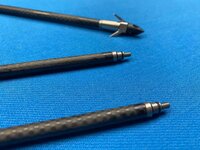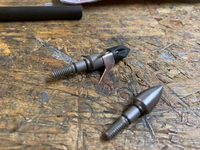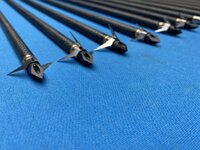Concentric of the shaft / parts can lead to stability issues in loss of energy pending how bad the issues are.
!. If you have all your arrows with just inserts slightly off well then me may not notice anything becasue all the arrows will be subject to the same issue and produce the same result, however is that what an archer strives more.. For me no as a shooter and an arrow builder definitively no. Given the choice I would do the reverse taper insert all day long..
Aside from being concentric the reverse taper adds strength because now there is a locking joint between carbon and insert / half out. When Aero concept inner tube is introduced then you have serveal inches of the shaft having a double wall also afixed to the insert / half out that have dampening characteristics. In the case of the heavy wall inner tuber for small diameter shafts the inner tube will come in at a thick 8gpi + Half out weight.
In regards to .166 shaft,, which was an idea i had intoruced Dorge to at the Harrisburg show a couple years ago. The aero concept design was quickly implemented for micro shafts. In picture here is what Aero concept looks like in a micro. The Broad head is the female end ,, this was to allow wall thickness in a micro., Maybe I'll run this application by Dorge for .204,, thoughts?
View attachment 391841






